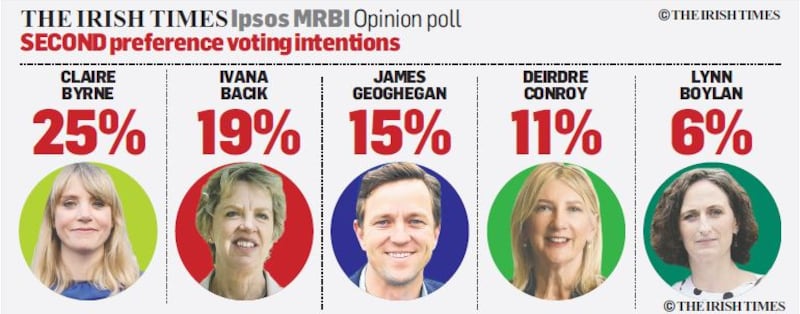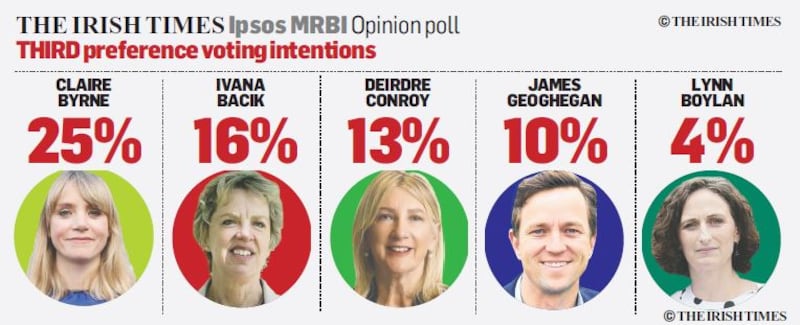Since battle commenced in the Dublin Bay South byelection campaign called after Eoghan Murphy’s retirement from politics, observers and some participants have billed it as a contest between Fine Gael and Sinn Féin.
And Fine Gael’s James Geoghegan, fighting in what is a traditional stronghold for the party, certainly faces a strong challenge. But on the basis of today’s special Irish Times/Ipsos MRBI byelection poll in the constituency, his challenger will be Labour’s Ivana Bacik, rather than Sinn Féin’s Lynn Boylan.
Neither Fianna Fáil candidate Deirdre Conroy nor the Green Party candidate Claire Byrne is really at the races. On the evidence of Monday's numbers, the contest is between Geoghegan and Bacik.

Caveats
Some caveats are necessary. The 500 sample (at 50 points throughout the constituency) is standard for a single-constituency poll but gives us a larger margin of error, at 4.4 per cent, than is typically the case with national polls. Also, there is a week and a bit to go in this campaign, and many voters will only really focus in on their choice in the last week. And turnout is notoriously difficult to predict. All that having been said, it’s clear that Fine Gael is in the driving seat.
The reason for that is this is not a constituency which is, on the whole, dissatisfied with the way this Government is running the country. That is the strongest wind in Geoghegan’s sails. The satisfaction ratings for the Government are comfortably in the net positive space, with 55 per cent of people across the constituency as a whole saying they are satisfied with how the Government is running the country, with 38 per cent saying they are dissatisfied.
Satisfaction ratings are highest among voters aged 65 or older (65 per cent); among those living in the Rathgar/Rathmines area (63 per cent), among the wealthiest ABC1 voters (63 per cent); amongst homeowners without a mortgage (76 per cent) and with a mortgage (65 per cent).
These are also the groups which show the highest support for the Fine Gael candidate, who has assumed the mantle of the Government candidate in a pro-Government constituency. That, at its simplest, is why he is in the lead, the poll suggests.

Class divide
The division by class and area is best seen when comparing the Fine Gael and Sinn Féin candidates in the wealthiest and least wealthy parts of the constituency. Sinn Féin candidate Lynn Boylan is at 26 per cent in the South East Inner City/Ringsend area – but at just 4 per cent in Rathmines/Rathgar. The position of James Geoghegan is reversed. He is at 34 per cent in Rathmines/Rathgar but just 10 per cent in the South East Inner City/Ringsend.
Looked at another way, and the division is just as clear. Across the constituency Sinn Féin is at 27 per cent among working class C2DE voters, but just 7 per cent among ABC1 voters. Fine Gael is at 31 per cent among the ABC1s and 16 among C2DEs.

Suburban appeal
Bacik is the challenger to Geoghegan because unlike Boylan, she has a strong appeal in the “satisfied suburbs” -–in fact, she is twice as strong in wealthier areas as she is in the more working class areas in the constituency. Her appeal is strong across the board to voters of other parties, too.
One of the strongest narratives since the last election has been the growth of Sinn Féin. If today’s results are replicated when the actual votes are cast next week, it will suggest that the project of extending the party’s reach into the middle classes – in this constituency at least – has much work to do.
That won’t be much comfort for Fianna Fáil, whose campaign for Deirdre Conroy has failed to ignite, these numbers suggest. A byelection flop would dent the recent good news for Micheál Martin from the national polls, but with the complicating factor that this is the constituency of Jim O’Callaghan, Martin’s perceived rival for the party leadership. And O’Callaghan, as Martin loyalists will remind everyone, is the director of elections.
Green Party candidate Claire Byrne won’t challenge for the seat on the basis of these numbers but is performing okay, and will be a magnet for transfers. Today’s poll bears out the national picture for the Greens since the party entered government – there just hasn’t been the collapse that many predicted.
The arithmetic of a byelection –when there is only one seat contested, and so the quota is 50 per cent plus one – works differently to a general election, when the quota is 20 per cent for a four-seater like Dublin Bay South. This means that the transfers will be decisive, and while the order of candidates in the first preference votes is usually not upset by transfers, the data today suggests that things are tight enough to keep Bacik in the hunt.
The Labour candidate should do well on second preferences, the poll suggests (with 19 per cent) though Geoghegan is also strong, on 15 per cent. There is also some evidence of “coalition coherence”, with the data suggesting a particularly strong transfer from Fianna Fáil to Fine Gael. Bacik also does well on third preferences, the poll suggests, at 16 per cent, with Geoghegan at 10 per cent.

Issues
Voters in the constituency were also asked whether local or national issues would most influence their vote, and two-thirds opted for national issues.
Of those who said that local issues would influence their vote, almost half mentioned housing-related issues. Even in this most affluent of constituencies, housing is the subject on voters’ minds.
Voters were also asked how they would vote in a general election, with the results as declared voters as follows: Fine Gael 37 per cent, Fianna Fáil 13 per cent, Greens 13 per cent; Sinn Féin 15 per cent; Labour 10 per cent; Social Democrats 4 per cent; People Before Profit 2 per cent; Aontú 1 per cent; Independents 4 per cent.











